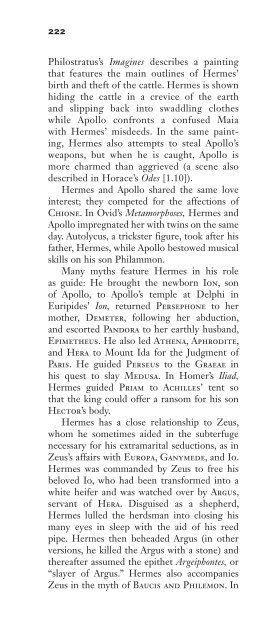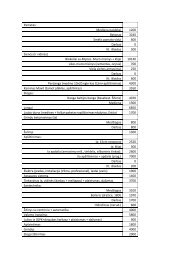Encyclopedia of Greek and Roman Mythology (Facts on File Library ...
Encyclopedia of Greek and Roman Mythology (Facts on File Library ...
Encyclopedia of Greek and Roman Mythology (Facts on File Library ...
Create successful ePaper yourself
Turn your PDF publications into a flip-book with our unique Google optimized e-Paper software.
Philostratus’s Imagines describes a painting<br />
that features the main outlines <str<strong>on</strong>g>of</str<strong>on</strong>g> Hermes’<br />
birth <str<strong>on</strong>g>and</str<strong>on</strong>g> theft <str<strong>on</strong>g>of</str<strong>on</strong>g> the cattle. Hermes is shown<br />
hiding the cattle in a crevice <str<strong>on</strong>g>of</str<strong>on</strong>g> the earth<br />
<str<strong>on</strong>g>and</str<strong>on</strong>g> slipping back into swaddling clothes<br />
while Apollo c<strong>on</strong>fr<strong>on</strong>ts a c<strong>on</strong>fused Maia<br />
with Hermes’ misdeeds. In the same painting,<br />
Hermes also attempts to steal Apollo’s<br />
weap<strong>on</strong>s, but when he is caught, Apollo is<br />
more charmed than aggrieved (a scene also<br />
described in Horace’s Odes [1.10]).<br />
Hermes <str<strong>on</strong>g>and</str<strong>on</strong>g> Apollo shared the same love<br />
interest; they competed for the affecti<strong>on</strong>s <str<strong>on</strong>g>of</str<strong>on</strong>g><br />
Chi<strong>on</strong>e. In Ovid’s Metamorphoses, Hermes <str<strong>on</strong>g>and</str<strong>on</strong>g><br />
Apollo impregnated her with twins <strong>on</strong> the same<br />
day. Autolycus, a trickster figure, took after his<br />
father, Hermes, while Apollo bestowed musical<br />
skills <strong>on</strong> his s<strong>on</strong> Philamm<strong>on</strong>.<br />
Many myths feature Hermes in his role<br />
as guide: He brought the newborn I<strong>on</strong>, s<strong>on</strong><br />
<str<strong>on</strong>g>of</str<strong>on</strong>g> Apollo, to Apollo’s temple at Delphi in<br />
Euripides’ I<strong>on</strong>, returned Perseph<strong>on</strong>e to her<br />
mother, Demeter, following her abducti<strong>on</strong>,<br />
<str<strong>on</strong>g>and</str<strong>on</strong>g> escorted P<str<strong>on</strong>g>and</str<strong>on</strong>g>ora to her earthly husb<str<strong>on</strong>g>and</str<strong>on</strong>g>,<br />
Epimetheus. He also led Athena, Aphrodite,<br />
<str<strong>on</strong>g>and</str<strong>on</strong>g> Hera to Mount Ida for the Judgment <str<strong>on</strong>g>of</str<strong>on</strong>g><br />
Paris. He guided Perseus to the Graeae in<br />
his quest to slay Medusa. In Homer’s Iliad,<br />
Hermes guided Priam to Achilles’ tent so<br />
that the king could <str<strong>on</strong>g>of</str<strong>on</strong>g>fer a ransom for his s<strong>on</strong><br />
Hector’s body.<br />
Hermes has a close relati<strong>on</strong>ship to Zeus,<br />
whom he sometimes aided in the subterfuge<br />
necessary for his extramarital seducti<strong>on</strong>s, as in<br />
Zeus’s affairs with Europa, Ganymede, <str<strong>on</strong>g>and</str<strong>on</strong>g> Io.<br />
Hermes was comm<str<strong>on</strong>g>and</str<strong>on</strong>g>ed by Zeus to free his<br />
beloved Io, who had been transformed into a<br />
white heifer <str<strong>on</strong>g>and</str<strong>on</strong>g> was watched over by Argus,<br />
servant <str<strong>on</strong>g>of</str<strong>on</strong>g> Hera. Disguised as a shepherd,<br />
Hermes lulled the herdsman into closing his<br />
many eyes in sleep with the aid <str<strong>on</strong>g>of</str<strong>on</strong>g> his reed<br />
pipe. Hermes then beheaded Argus (in other<br />
versi<strong>on</strong>s, he killed the Argus with a st<strong>on</strong>e) <str<strong>on</strong>g>and</str<strong>on</strong>g><br />
thereafter assumed the epithet Argeiph<strong>on</strong>tes, or<br />
“slayer <str<strong>on</strong>g>of</str<strong>on</strong>g> Argus.” Hermes also accompanies<br />
Zeus in the myth <str<strong>on</strong>g>of</str<strong>on</strong>g> Baucis <str<strong>on</strong>g>and</str<strong>on</strong>g> Philem<strong>on</strong>. In<br />
Hermes<br />
Apollodorus, Hermes killed the giant Hippolytus<br />
in the Gigantomachy.<br />
Hermes is associated with fertility <str<strong>on</strong>g>and</str<strong>on</strong>g><br />
prosperity. A herm, a phallic pillar surmounted<br />
by a head, was placed in towns <str<strong>on</strong>g>and</str<strong>on</strong>g> <strong>on</strong> thresholds<br />
as a good omen. Despite this link to<br />
fertility, Hermes’ <str<strong>on</strong>g>of</str<strong>on</strong>g>fspring were few—when<br />
they can be said with authority to be his—<str<strong>on</strong>g>and</str<strong>on</strong>g><br />
his loves were few. Some authors, but not<br />
all, identify Autolycus, Cephalus, Eurytus,<br />
Eudorus, <str<strong>on</strong>g>and</str<strong>on</strong>g> Pan as s<strong>on</strong>s <str<strong>on</strong>g>of</str<strong>on</strong>g> Hermes. Another<br />
<str<strong>on</strong>g>of</str<strong>on</strong>g>fspring attributed to him is Hermaphroditus,<br />
whose mother was Aphrodite. In Ovid’s<br />
Metamorphoses, Hermes fell in love with Herse<br />
(see Aglaurus <str<strong>on</strong>g>and</str<strong>on</strong>g> Herse), daughter <str<strong>on</strong>g>of</str<strong>on</strong>g> King<br />
Cecrops <str<strong>on</strong>g>of</str<strong>on</strong>g> Athens, <str<strong>on</strong>g>and</str<strong>on</strong>g> when Herse’s sister<br />
Aglaurus became inflamed by Envy (at the<br />
instigati<strong>on</strong> <str<strong>on</strong>g>of</str<strong>on</strong>g> Athena), Hermes turned her to<br />
st<strong>on</strong>e. In Apollodorus’s <strong>Library</strong>, Hermes loved<br />
Apemosyne, descendant <str<strong>on</strong>g>of</str<strong>on</strong>g> King Minos <str<strong>on</strong>g>of</str<strong>on</strong>g><br />
Crete.<br />
In additi<strong>on</strong> to his more prominent functi<strong>on</strong>s<br />
as messenger <str<strong>on</strong>g>and</str<strong>on</strong>g> guide, Hermes was associated<br />
with prosperity in commerce—he is said to<br />
have invented weights <str<strong>on</strong>g>and</str<strong>on</strong>g> measures—<str<strong>on</strong>g>and</str<strong>on</strong>g> created<br />
the first wrestling schools. Hermes’ broad<br />
domain <str<strong>on</strong>g>of</str<strong>on</strong>g> resp<strong>on</strong>sibility is the basis for a comic<br />
complaint, in Lucian’s Dialogues <str<strong>on</strong>g>of</str<strong>on</strong>g> the Gods (4),<br />
about the incredible quantity <str<strong>on</strong>g>of</str<strong>on</strong>g> work for which<br />
the young god is resp<strong>on</strong>sible.<br />
Visual representati<strong>on</strong>s <str<strong>on</strong>g>of</str<strong>on</strong>g> Hermes in antiquity<br />
depict a youthful god, sometimes bearded<br />
<str<strong>on</strong>g>and</str<strong>on</strong>g> sometimes not, wearing easily identifiable<br />
attributes: winged s<str<strong>on</strong>g>and</str<strong>on</strong>g>als, helmet, <str<strong>on</strong>g>and</str<strong>on</strong>g><br />
caduceus. Postclassical images such as Andrea<br />
Mantegna’s Parnassus <str<strong>on</strong>g>of</str<strong>on</strong>g> 1497 (Louvre, Paris)<br />
follow similar ic<strong>on</strong>ographic c<strong>on</strong>venti<strong>on</strong>s. He<br />
is shown stealing the cattle <str<strong>on</strong>g>of</str<strong>on</strong>g> Apollo <strong>on</strong> an<br />
Attic black-figure hydria from the sixth century<br />
b.c.e. (Louvre, Paris). Hermes appears in<br />
images that represent the underworld as <strong>on</strong> an<br />
Apulian red-figure volute krater from ca. 330<br />
b.c.e. (Antikensammlungen, Munich). Here<br />
Hades <str<strong>on</strong>g>and</str<strong>on</strong>g> Perseph<strong>on</strong>e are shown with other<br />
figures associated with the world <str<strong>on</strong>g>of</str<strong>on</strong>g> the dead,<br />
including Orpheus, Sisyphus, <str<strong>on</strong>g>and</str<strong>on</strong>g> Hermes.







